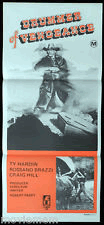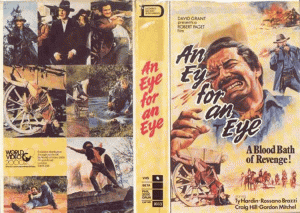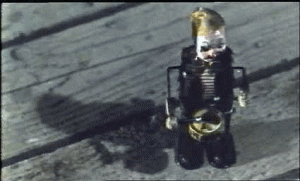From Monthly Film Bulletin, October 1974 (vol. 41, no. 489). –- J.R.
Drummer of Vengeance
Great Britain, 1974
Director: Robert Paget
 The American West, shortly after the Civil War. A rebel soldier who goes over to the Union army returns home to find his Indian wife and his son murdered — the former after having been raped — and their house burned to the ground by vengeful Confederates. Coming upon a wind-up toy drummer in the ruins, he vows to track down and kill all the men responsible. His usual method of revenge is to wind up the toy, place it on the ground, and ask his victim to make his play — whether armed or unarmed – before shooting him. He pays a carpenter to make the necessary coffins in advance and quickly dispatches six of the men he is after. The angry townsfolk, eager to be rid of the avenger (known only as the Stranger) and anxious for Sheriff Mason to apprehend him, are spurred on by the fanatical Bible-spouting of the town’s gravedigger — actually the Stranger in disguise. The Stranger also impersonates an Indian in a lance-throwing act in O’Conner’s Travelling Show in order to kill his next victim. and meets Prairie Flower, a member of the troupe, who reminds him of his wife. When the show leaves town, some of the members of the sang he is after hold up the wagons and take them over, but all are subsequently killed either by the Stranger, by each other, or by one of Mason’s deputies. Two of them are in the process of torturing Prairie Flower to extract information when the Stranger and deputy arrive. Discovering that Mason is the gang’s leader, the Stranger returns to town to kill him and then departs.
The American West, shortly after the Civil War. A rebel soldier who goes over to the Union army returns home to find his Indian wife and his son murdered — the former after having been raped — and their house burned to the ground by vengeful Confederates. Coming upon a wind-up toy drummer in the ruins, he vows to track down and kill all the men responsible. His usual method of revenge is to wind up the toy, place it on the ground, and ask his victim to make his play — whether armed or unarmed – before shooting him. He pays a carpenter to make the necessary coffins in advance and quickly dispatches six of the men he is after. The angry townsfolk, eager to be rid of the avenger (known only as the Stranger) and anxious for Sheriff Mason to apprehend him, are spurred on by the fanatical Bible-spouting of the town’s gravedigger — actually the Stranger in disguise. The Stranger also impersonates an Indian in a lance-throwing act in O’Conner’s Travelling Show in order to kill his next victim. and meets Prairie Flower, a member of the troupe, who reminds him of his wife. When the show leaves town, some of the members of the sang he is after hold up the wagons and take them over, but all are subsequently killed either by the Stranger, by each other, or by one of Mason’s deputies. Two of them are in the process of torturing Prairie Flower to extract information when the Stranger and deputy arrive. Discovering that Mason is the gang’s leader, the Stranger returns to town to kill him and then departs.
 Within the confines of this cliché-ridden, Leone-derived Western there is at least one potentially intriguing idea: the hero paying for coffins to be made for his future victims, and then disguising himself with tinted glasses and other paraphernalia to become the hell-fire gravedigger who buries them, thus turning his own platitudes against himself when he cries for vengeance against the avenger. Unfortunately, the ironies behind this conceit are scarcely even scratched, and what remains is an inventory of stock violence and all-too-familiar scenes and characters rendered almost as mechanically as the movements of the hero’s featured toy. The stylistic departures consist of freeze-frames to punctuate the first few murders and what appears to be a fish-eye lens to enclose one of the family flashbacks. The moral tenor of the plot can be fairly gauged both by Prairie Flower’s tribute to the Stranger –- “Yours is not vengeance but justice. I see a man pure in spirit” –- and by the fact that she is ultimately left stranded by film and hero alike, tied to a wagon wheel after having been tortured, so that the remaining killings can claim his (and our) total attention with the distraction of even determining whether she’s dead or alive. Regrettably, however, even the hero’s ‘purity’ of purpose is marred by the fact that many of his victims are not given the toy-drummer treatment: two are lanced and knifed respectively from a moving horse, making the warm-up ritual impractical, while a third is shot by the deputy, causing the Stranger considerable chagrin.
Within the confines of this cliché-ridden, Leone-derived Western there is at least one potentially intriguing idea: the hero paying for coffins to be made for his future victims, and then disguising himself with tinted glasses and other paraphernalia to become the hell-fire gravedigger who buries them, thus turning his own platitudes against himself when he cries for vengeance against the avenger. Unfortunately, the ironies behind this conceit are scarcely even scratched, and what remains is an inventory of stock violence and all-too-familiar scenes and characters rendered almost as mechanically as the movements of the hero’s featured toy. The stylistic departures consist of freeze-frames to punctuate the first few murders and what appears to be a fish-eye lens to enclose one of the family flashbacks. The moral tenor of the plot can be fairly gauged both by Prairie Flower’s tribute to the Stranger –- “Yours is not vengeance but justice. I see a man pure in spirit” –- and by the fact that she is ultimately left stranded by film and hero alike, tied to a wagon wheel after having been tortured, so that the remaining killings can claim his (and our) total attention with the distraction of even determining whether she’s dead or alive. Regrettably, however, even the hero’s ‘purity’ of purpose is marred by the fact that many of his victims are not given the toy-drummer treatment: two are lanced and knifed respectively from a moving horse, making the warm-up ritual impractical, while a third is shot by the deputy, causing the Stranger considerable chagrin.
JONATHAN ROSENBAUM

